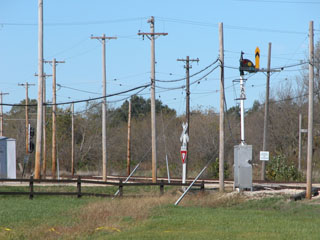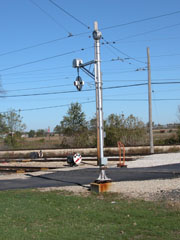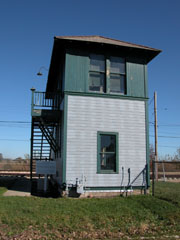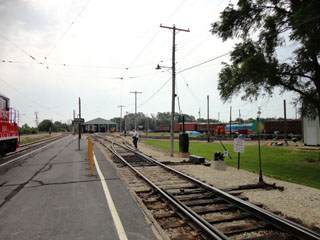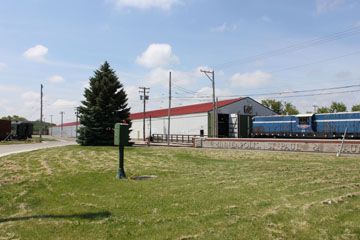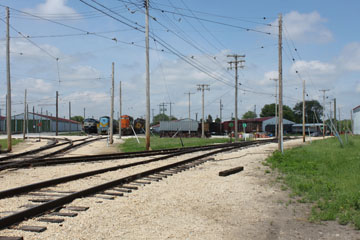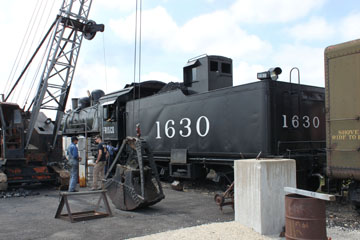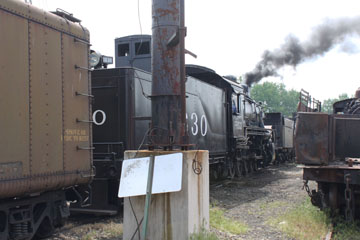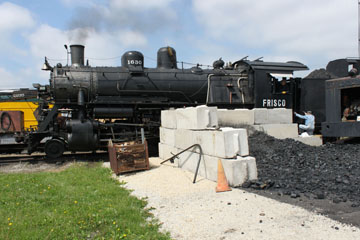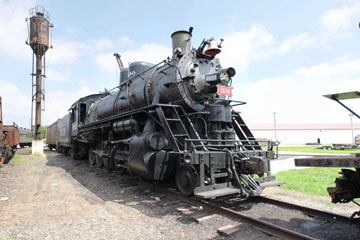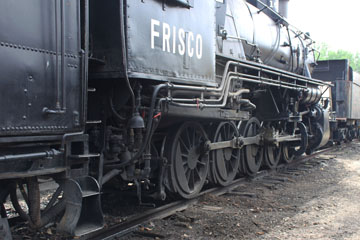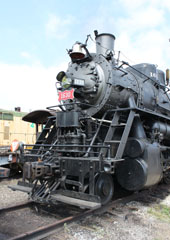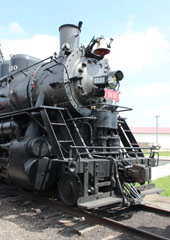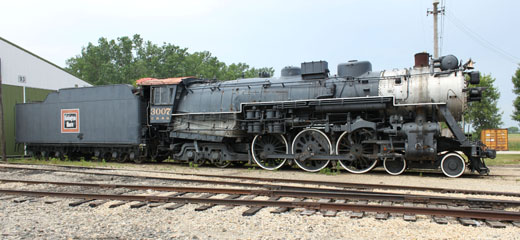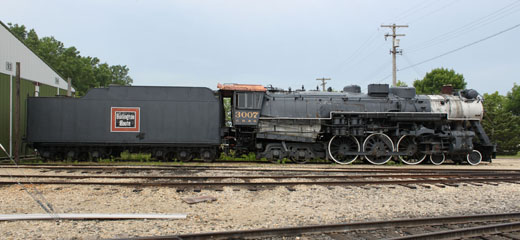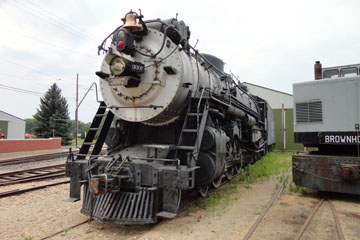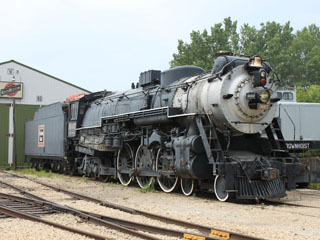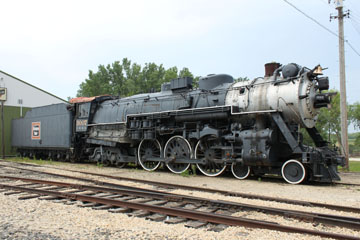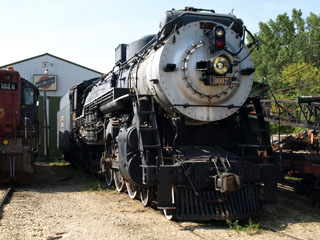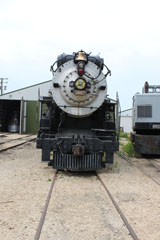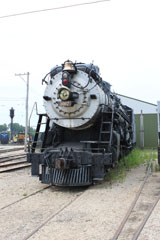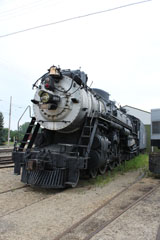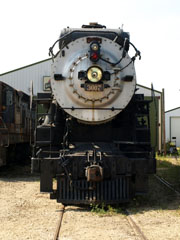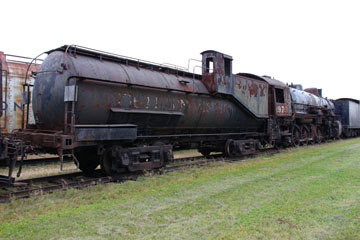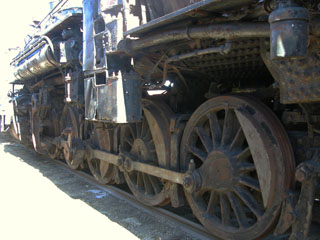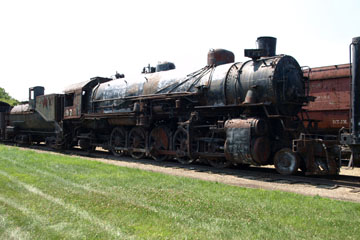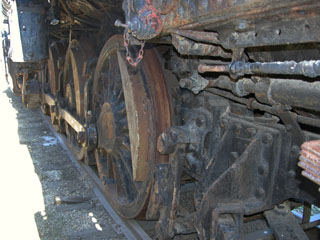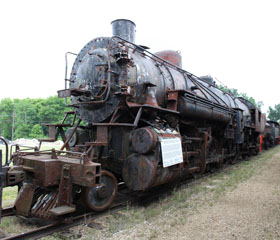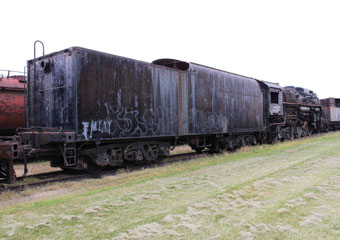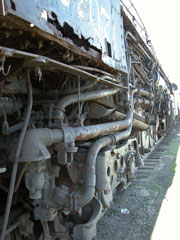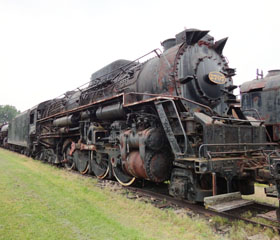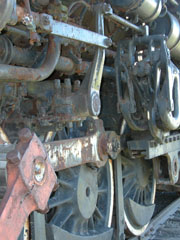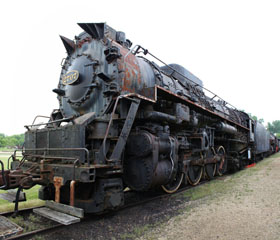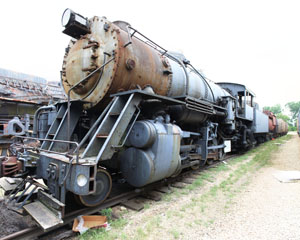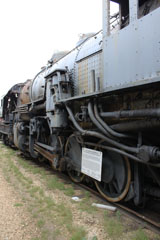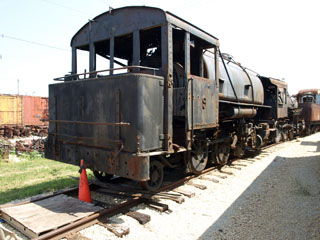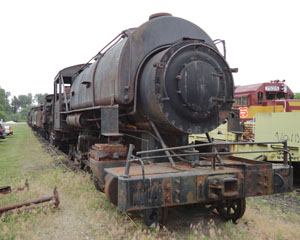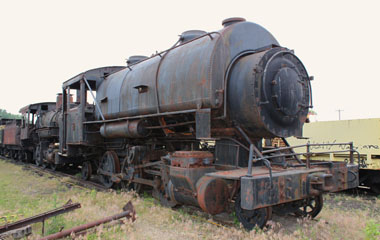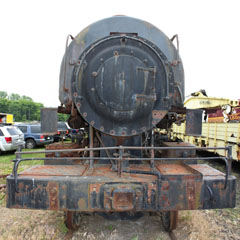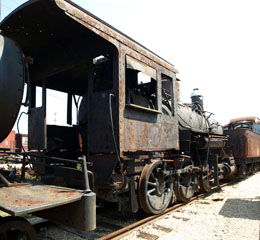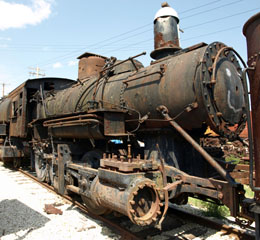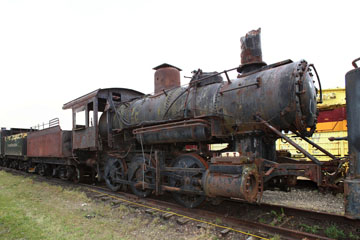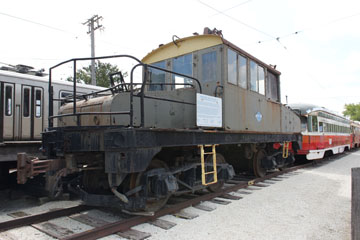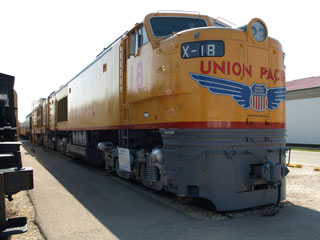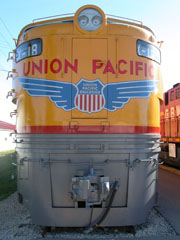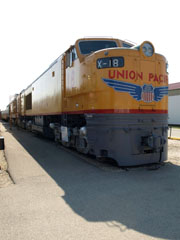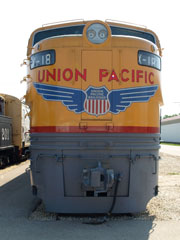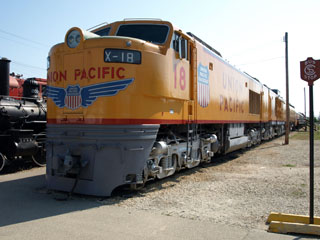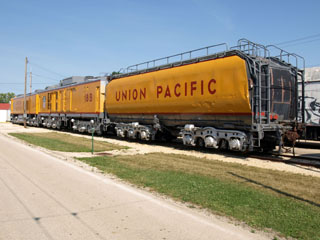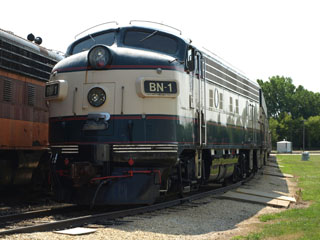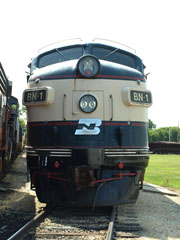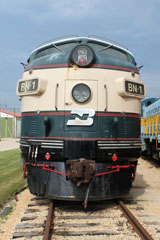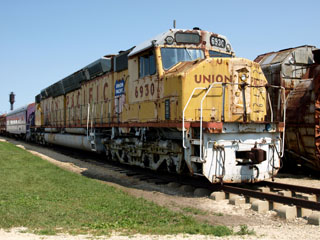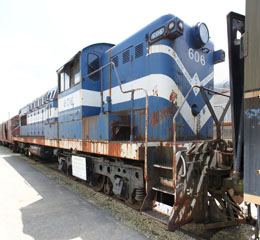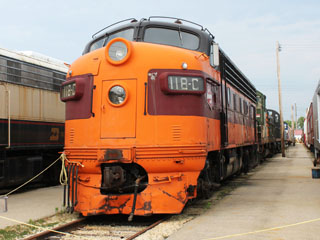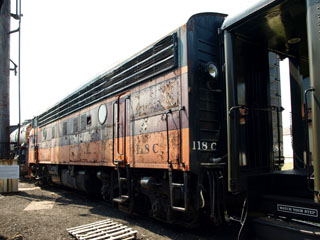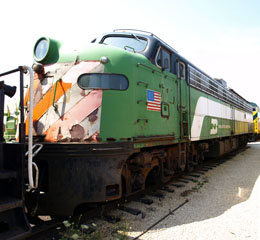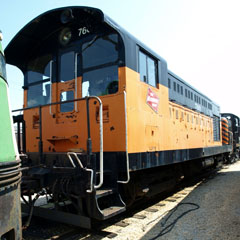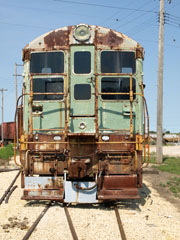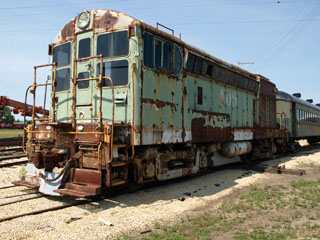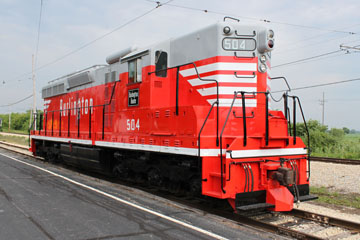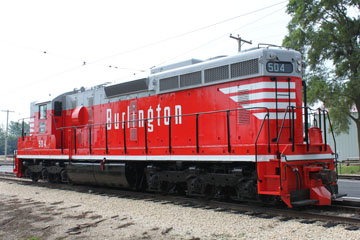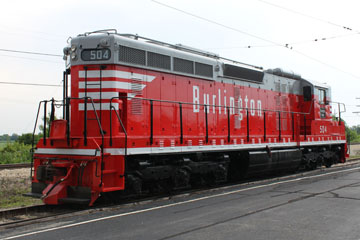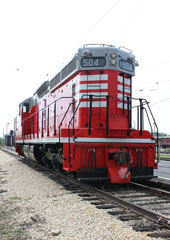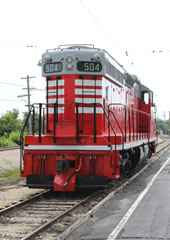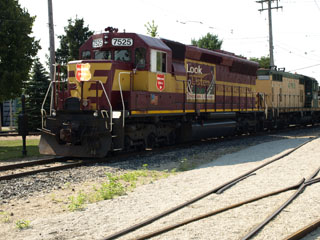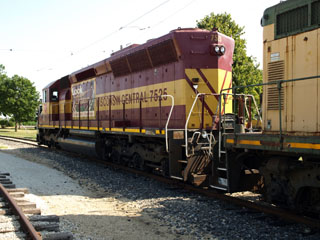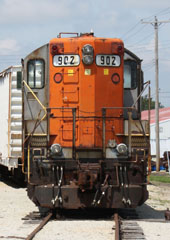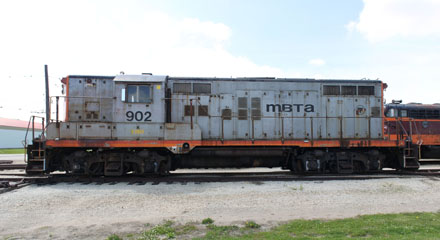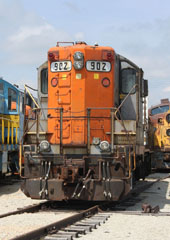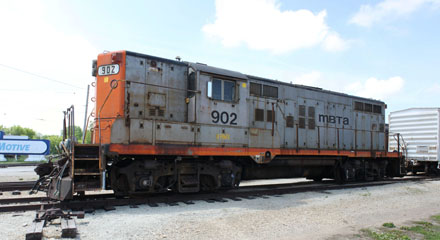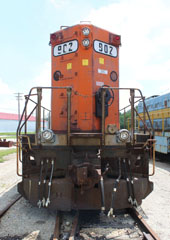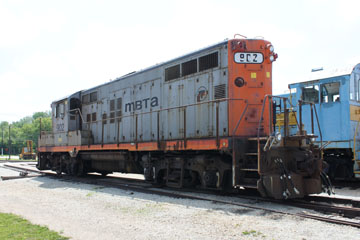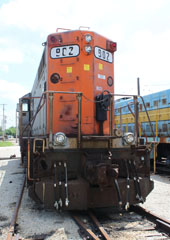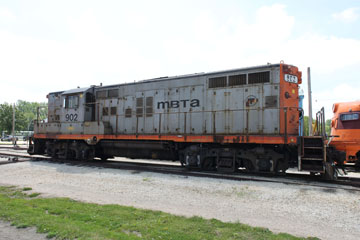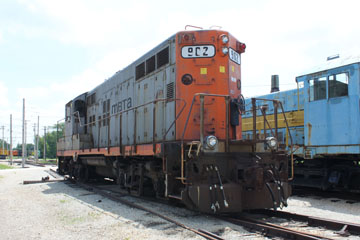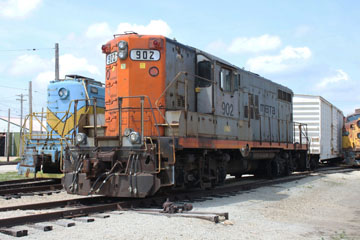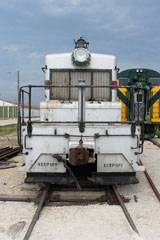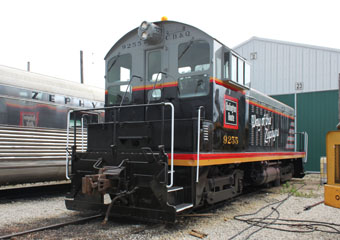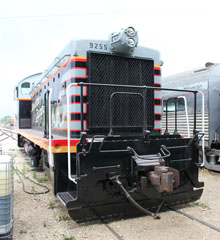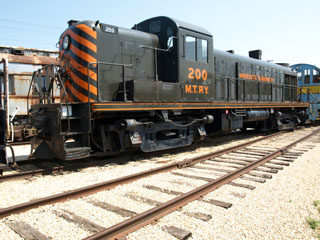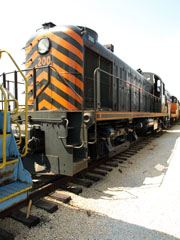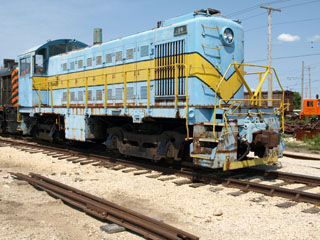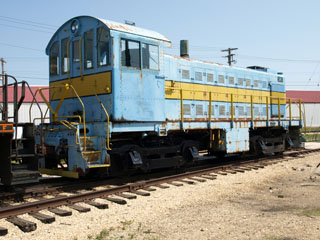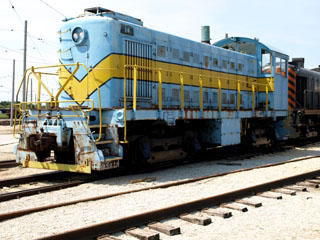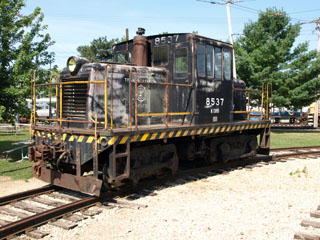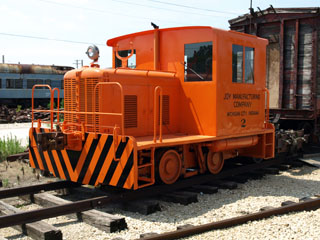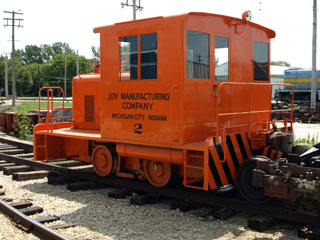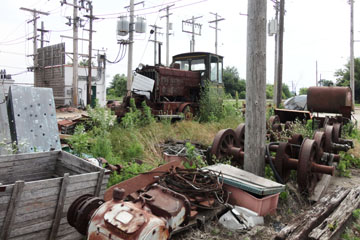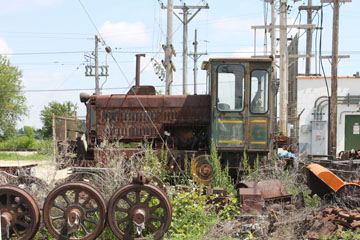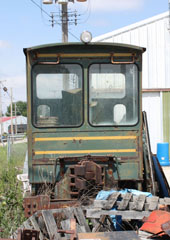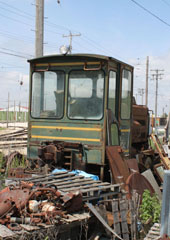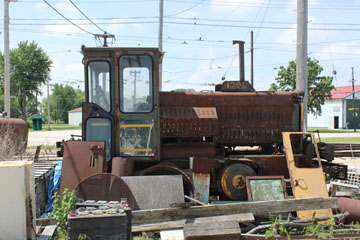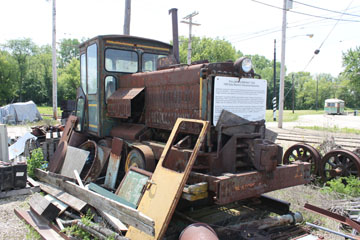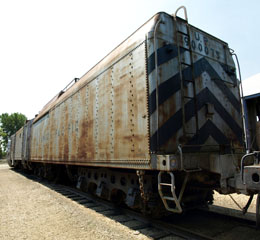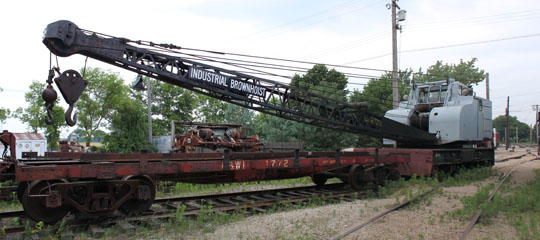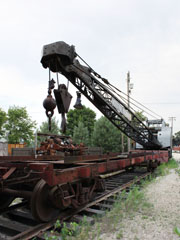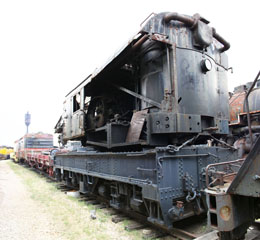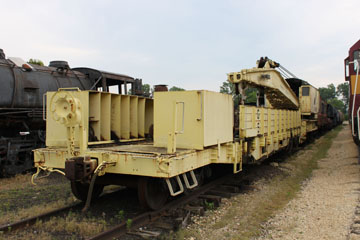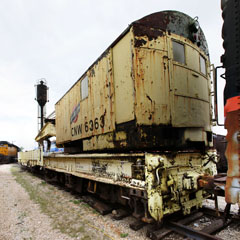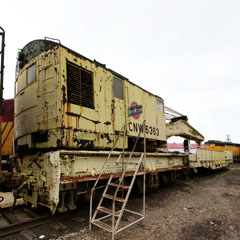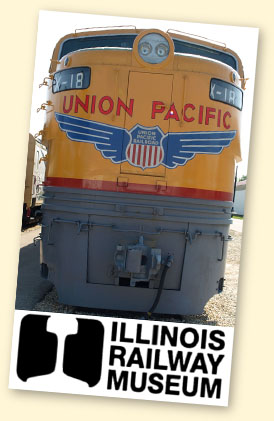

The Illinois Railway Museum is located at 7000 Olson Rd about a mile east of Union, IL, and fifty-five miles from Chicago.
The museum was started in 1953 by a group of volunteers who bought Indiana Railroad interurban car #65. It is now the largest railroad museum in the US and, because of its size, I have split the collection over two pages. This page shows locomotives in the yard. The Illinois Railway Museum Train Shed page shows equipment on display in Barn 9.
I have been to the museum several times and the photos are from various visits.

The museum has ten equipment storage barns, which include displays of passenger, rapid transit and interurban cars. It also has a dedicated steam restoration shop, an 1853 train depot, a complete Chicago Rapid Transit Company elevated station, four streetcar stations of different designs and an indoor dining facility.
Below, two views looking east towards the museum's diesel shop. The upper view is from the platform of the depot building. The lower view is further towards the shop.
Originally called the Illinois Electric Railway Museum, the name was changed to Illinois Railway Museum in 1961 to reflect its expanding collection. Initially located on the grounds of the Chicago Hardware Foundry in North Chicago, IL, in 1964, the entire collection was moved to its current site along the former right-of-way of the Elgin & Belvidere interurban.
The museum still runs electric trains and interurbans April-October, and diesel and steam trains May to September.
Above, this interlocking tower was built in 1890 to protect the junction of the Milwaukee Road and Elgin, Joliet & Eastern at Spaulding, just east of Elgin, IL. Updated in 1909, it housed a thirty-six lever, hand operated interlocking machine.
Closed in 1980, it was donated in 1988.

When I last visited, ex-SLSF/Eagle-Picher #1630 had been fired up.
#1630 was built in 1918 by the Baldwin Locomotive Works for use in Russia as a class Ye Decapod
(2-10-0) type locomotive but it, along with about two hundred others, remained in the US due to the inability of the Bolshevik government to pay for them following the Russian Revolution in 1917. The undelivered engines were transferred to the US Railroad Administration, and the SLSF acquired #1630 from them in 1920, along with nineteen other "orphaned" Decapods.
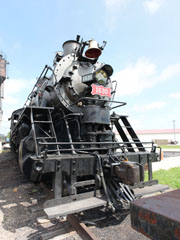
Built for the Russian 5' gauge, the locomotives were not regauged for the standard 4' 8½" gauge. The front pilot was replaced but the drivers were simply fitted with wider tyres. Although these caused them to climb over the rail on tight curves, the Frisco still thought them good engines for work on secondary lines.
Over the years, the
Frisco fitted stokers and a single thermic syphon to their Decapods.
#1630 was then one of five sold to the Eagle-Picher Company, who used it to haul lead ore from a mine to their smelter at the company's southeastern Oklahoma zinc mines until 1957.
All five Eagle-Picher Decapods survive.
You can see #1621 on the National Museum of Transportation, St. Louis Yard page of this website, #1625 is on the Museum of the American Railroad page and #1632 is on the Belton, Grandview & Kansas City Railroad page.
Weighing 210,000 lbs with a driver wheelbase of
18' 8" and engine wheelbase of 27’ 10", #1630 has 25" x 28" cylinders and 52" drivers. With a 65 sq ft grate, 227 sq ft firebox, total heating surface of 3,189 sq ft, including 579 sq ft superheating, it operates at a boiler pressure of 180 psi delivering 51,490 lbs tractive effort.
In 1965, the locomotive was donated to the Illinois Railway Museum, where it began operating in 1973. It was taken out of service in 2004 and, following a federally mandated rebuild, it was returned to operations in October 2013.

#3007 is one of twelve Hudson type (4-6-4) locomotives bought from Baldwin by the Chicago, Burlington & Quincy in 1930 (#3000-#3011). Designated Class S-4, with 78" drivers, they were designed for fast passenger service.
The new locomotives went into service pulling trains such as the Ak-Sar-Ben, the Aristocrat and the Black Hawk, eliminating the need to swap one locomotive for another during the trip. They were also fast: one is credited with hauling ten standard passenger cars between Cochrane and La Crosse, WI, at 112 mph.
#3007 weighs 391,880 lbs, 207,730 lbs on its drivers. The tender weighs 326,050 lbs light and has a capacity of 24 tons of coal and 15,000 gallon of water.
With a Type B automatic stoker and an 87.9 sq ft grate area, the S-4's 369 sq ft firebox was fitted with 43 sq ft of arch tubes and had a 70 sq ft combustion chamber. An additional 1,830 sq ft of superheating brought the total heating surface to 6,077 sq ft.
The S-4 has 25" x 28" cylinders and 14" diameter piston valves. Operating at a boiler pressure of 250 psi, it delivered 47,676 lbs tractive effort.
The S-4 was one of the most successful steam locomotives operated by the CB&Q. #3002 was streamlined to haul the stainless-steel Zephyrs. Renumbered #4000, named Aeolus (keeper of the wind) and nicknamed "Big Alice the Goon", after its success, a second was built from scratch numbered #4002.
Four other S-4s have survived. You can see photos of the other survivors on the CBQ
S-4 #3001, CBQ S-4 #3003, CBQ S-4 #3006 and CBQ S-4 #4000 pages of this website (#4000's shroud was removed in 1940).

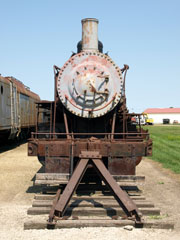

This Mogul (2-6-0) type locomotive was built by Brooks Locomotive Works, later part of Alco, for the Illinois Central as #560 in 1900. It was renumbered #3719 in 1937 and then #3706 in 1946. It was sold to the Bevier & Southern Railroad Co., at Bevier, MO, as #109, then in 1963 to the Steamtown Foundation and finally to the IRM in 1986.
#3706 was upgraded in 1920 with 400 sq ft of superheating. The 32.7 sq ft grate, 211 sq ft firebox and 15 sq ft of arch tubes were retained, giving it a total heating surface of 2,375 sq ft. With
20" x 28" cylinders and 63" drivers, it operated at a boiler pressure of 200 psi delivering 30,222 lbs tractive effort. The current tender is from a different locomotive.
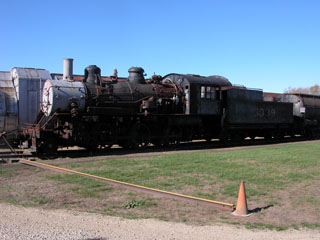
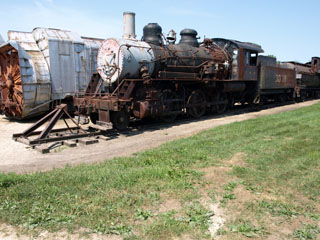


An oil burner, #975 weighs 352,000 lbs. The tender weighs 173,460 lbs light with a 10,030 gallon water and 3,120 gallon oil capacity.
The locomotive has Walschaert valve gear, 27½" x 32" cylinders and 63½" drivers. With a 63 sq ft grate, 332 sq ft firebox and total heating surface of 5,412 sq ft, including 950 sq ft superheating, it operated at a boiler pressure of 200 psi delivering 64,787 lbs tractive effort.
Above, another one of four locomotives on what is very much an IRM "dead line". Click this link to open a swf part panorama of all four:
is very much an IRM "dead line". Click this link to open a swf part panorama of all four:
The Texas & New Orleans took delivery of twelve Santa Fe (2-10-2) type locomotives from Alco in 1918 (#970-#981). The same design as twelve delivered to T&NO's parent, the Southern Pacific by Alco in 1917, they were also designated Class
F-1. As the name suggests, the first of this type of locomotive was built by Baldwin in 1903 for the AT&SF, generally known as the "Santa Fe".
Because of the name's association with a rival railroad carrier, however, SP crews were apparently reluctant to refer to these locomotives as "Santa Fes", so they dubbed them "Decks" for deca or ten, the number of drivers.
The SP and T&NO eventually acquired one
hundred and eighty-two "Decks" between 1917 and 1924 from a variety of builders. However, only two have survived. As well as #976 at the IRM, ex SP #3651, transferred to the T&NO and renumbered #982, is on display at TRPA Union Station in Houston, TX.


#2707 is one of forty Berkshire type (2-8-4) locomotives built for the C&O by Alco in 1943 and 1944 (#2700-#2739), although they were known as "Kanawhas" on the C&O after the river that cut through its operational heartland in West Virginia. It has 26" x 34" cylinders and 69" drivers. Operating at a boiler pressure of 245 psi it delivered 69,368 lbs tractive effort.
Designed for fast freight, the first K-4s also hauled passenger trains and performed so well that ten more were ordered from Lima in 1945 (#2740-#2749).
Ten more came from Lima (#2750-#2759) and another thirty from Alco in 1947 (#2760-#2789).
Twelve K-4s have survived. You can see #2700 on the CO #2700 page of this website, CO #2705 on the B&O Museum Yard & Car Shop page, CO #2716 on the Kentucky Railway Museum, CO #2727 on the National Museum of Transportation, St. Louis Train Sheds, CO #2736 on the National Railroad Museum and #2789 on the Hoosier Valley Railroad Museum pages, and CO #2732, CO #2755, CO #2756, CO #2760, and CO #2776 each have their own page.


Based on a USRA design, #8380 is one of over seventy 0-8-0 switchers bought by the Grand Trunk Western for its Chicago-Detroit system. It weighs 214,100 lbs and has 51" drivers and
22" x 28" cylinders. Operating at 200 psi, it delivered 45,175 lbs tractive effort.
Sold to the Northwestern Steel & Wire Company in 1960, it was converted to burn oil and worked at the company's Sterling, IL, plant where hundreds of other steam locomotives were being scrapped until 1981, when it was donated to the museum.

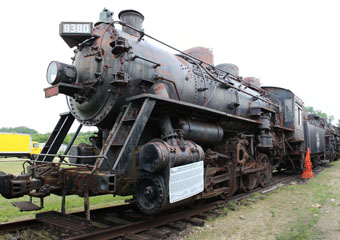

Weighing 268,000 lbs, 238,000 lbs on its 57" drivers, #35 is relatively heavy for a Consolidation. It has 26" x 30" cylinders, a 58.7 sq ft grate and 245 sq ft firebox, which includes 29 sq ft of arch tubes. With an additional 844 sq ft of superheating, its total heating surface was 4,487 sq ft and, operating at a boiler pressure of 185 psi, it delivered 55,948 lbs tractive effort.
Below, a booster was mounted on the front tender truck using side rods to to power both axles.
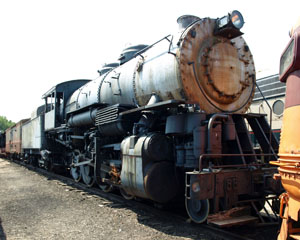
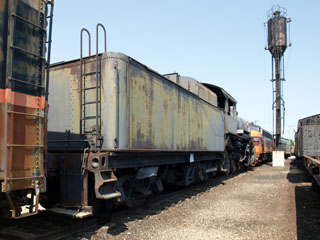
Built as #19, one of three (2-8-0) Consolidation type locomotives Baldwin delivered to the Lake Superior & Ishpeming in 1916 (#18-#20), this locomotive was renumbered #35 in 1923. It hauled drag freight on the south shore of Lake Superior until sold to the Marquette & Huron Mountain tourist railroad in 1963 along with the other two 1916 Consolidations (#32 & #34). Both #34 and #35 were bought by the IRM in 1985.
#34 was eventually sold to the Western Maryland Scenic Railroad in 1992, converted to make it look more like a Western Maryland Class H-7 2-8-0 locomotive and renumbered #734 (you can see it in steam on the Western Maryland Scenic Railroad page of this website).



This relatively rare 2-6-2T (Prairie type Tank locomotive) was built by H. K. Porter in 1925 for the Coronet Phosphate Co., and worked as #9 at a plant in Coronet, FL, until sold to a private dealer in 1968. It then passed through a number of different owners until it was donated to the museum in 2008.
#9 was an oil burner with 17" x 24" cylinders
and 43" drivers. Weighing 130,000 lbs (103,000 lbs on its drivers) and operating at a boiler pressure of 180 psi, it delivered 24,680 lbs tractive effort.

In 1968, #18 was sold on to R. L. Johnson and George Silcott, another dealership and then to the Thompson Winery in Monee, IL. It was finally donated to the museum in 2008.
A coal burner with 48" drivers and 16" x 24" cylinders, #18 weighs 90,000 lbs (75,000 on its drivers). Operating at a boiler pressure of 140 psi, it delivered 15,230 lbs tractive effort. It has a low tender of the kind suited to shortline and switching duties. The locomotive is in a particularly bad state, rusting, lacking the slide valves and with its smokestack almost gone.
Built for the Redman Lumber Co., as #12 by Baldwin in 1920, this
2-6-0 Mogul type locomotive is lacking its front pilot, which makes it appear to be an 0-6-0 switcher.
At some point, it was sold to Georgia Car & Locomotive, then to the Lee Tidewater Cypress Co., in Copeland, FL, as #18. It moved to the J. C. Turner Lumber Co., as #18 and was sold to the Edaville Corp., of Copeland, FL, in 1962.

The Milwaukee Electric Railway & Light Co. was the largest electric railway system in Wisconsin. Its Milwaukee lines served most of the city and its interurban lines ran throughout southeastern Wisconsin. It had streetcar lines in Appleton, Kenosha and Racine, did its own switching operations at power plants in Port Washington and Lakeside and operated its own shops, which could repair, rebuild or build complete streetcars, interurbans and freight locomotives.
L3 is 31' 8" long and weighs 100,000 lbs. Its four GE 207B motors power four M100AB trucks.
Milwaukee Electric Railway & Light Company L3 was built at the company’s Cold Spring, WI, works in 1920 and was originally equipped with poles and a pantograph. The pantograph was removed and a cable reel installed in 1927. In 1948 it was at the company’s Port Washington, WI, plant and then became Wisconsin Electric Power Company L3 in 1963.
It was acquired by the Wisconsin Electric Railway Historical Society in 1972, was sold to a private individual in 1988 and bought by the Illinois Railway Museum in 1991.


Above, #18 is one of only two Union Pacific gas-turbine locomotives to survive (you can see the other, UP #26, on the Ogden Union Station page of this website). Complete with its B unit and tender, it is a truly impressive sight!
Unlike so many of the Consolidations, Big Boys, Centennials and other smaller locomotives donated to museums and cities, both turbines were not directly donated by the UP. In 1975, they were in a dead line at Intercontinental Engineering's facility in Riverside, MO, ready to be cut up for scrap and parts for other uses.
UP's order for thirty turbines followed testing of a smaller prototype, #50 built by Alco-GE, and delivery of twenty-five smaller units (#51-#75). The huge, two-unit locomotives #1-#30, were delivered during 1958 to 1961. All were equipped with fuel tenders from the start, as well as multiple unit connections so one or more trailing diesels could be controlled from the turbine's cab. Some were eventually upgraded to 10,000 hp.
Once in operation, they quickly earned the nickname "Big Blows" because of the deafening noise they made.
Through the efforts of various individuals, however, the two A-B units were spared the torch. The IRM acquired #18 in late 1992 and moved it to Union, ironically having scrapped three other turbine A units already in its ownership (#14, #16 & #29) as well as the A-B set #28.
Like many of the Union Pacific's purpose built locomotives, these were a one of a kind design. Powered by the same technology as jet airplanes, they were the most powerful locomotives ever to run.
The UP rostered the largest fleet of turbine freight locomotives in the world: at one time, they claimed turbines hauled 10% of their entire freight. They were initially quite cost-effective, despite poor fuel economy, because they used residual fuel oils, "Bunker-C oils", the same fuel used in oil burning steam locomotives.
However, as other uses were found for these heavier petroleum by-products, particularly plastics, the turbine units became too expensive to operate.
The UP calculated a single turbine unit could haul seven hundred and thirty-four freight cars (a train over seven miles long) at a steady 12 mph.
The "Big Blows" started running from Ogden, UT, to Los Angeles, CA, but, after four months with temperatures nudging 115°F that didn't allow the turbines to perform at their best, they were pulled back to work from Ogden, UT, to Council Bluffs, IA. There may also have been complaints from LA residents about the turbines' noise.
Above, note the auxiliary tender. Based on a steam locomotive design, it holds 24,000 gallons of oil in addition to the 2,500 gallons provided by the B unit.
#18 A is over 80' long, and the combined A-B unit is 165' 11" long and weighs 849,248 lbs. The A unit housed the cab, an 850 hp diesel engine and other control equipment. The B unit housed
the electric generators and an 8,500 hp GTEL turbine that powered the twelve GE 752E4 traction motors.
All the turbines had been retired by 1970. The trucks and traction motors from the other units were used to build EMD's U50C diesel-electrics. Several of the tenders were also retained and converted to hold water for UP's operating steam locomotives, including UP FEF-3 844 and UP Challenger #3985.


The trainset above combines two EMD F9 units (#BN-1 & #BN-2) and one E9 (#BN-3).
The BN-1 and BN-2 combination was outshopped from Burlington Northern's West Burlington Shops, IA, in September 1990 to form part of BN's Executive fleet.
Built in 1954, BN-1 started out as Northern Pacific #6700A. When the Burlington Northern was formed in 1970, it was renumbered BN #9800, then demoted to freight service as #766. For a while it was used as Rotary Snow Plow Power Unit #972567 before having its 567C prime mover replaced at West Burlington with a 645E to GP38-2 standards with Dash-2 electrical components for the Executive Fleet.
BN-2 was also built in 1954. It started life as Northern Pacific #7002C and then became BN #809 when it was demoted to freight service.
The two units were the first to adopt BN's new livery of Grinstein Green (named after then president of the railroad, Gerald Grinstein), Cream and Alizarin Red.
This departure from the standard Cascade Green, White and Black colour scheme was shortlived, however, continuing only on the railroad's EMD SD70MACs until BNSF #9837 (you can see an example of the green, white and black livery on BN #5383 on the Illinois Railway Museum Train Shed page of this website).
BN-3 was built as CBQ E9 #9989A by EMD in January 1956 and became #9989 under the Burlington Northern.
Like BN #9908, also in the museum's
collection, it was upgraded to 2,400 hp by replacing its twin 12 cylinder 567B prime
movers with 645CEs by Morrison-Knudsen of Boise, ID, in 1973. It then entered Chicago commuter service as BN E9AM #9919, the Joseph F. Coyle, technically owned by Chicago's West Suburban Mass Transit District and leased back to BN.
Like BN-1, BN-2 also spent time as a Rotary Snow Plow Power Unit (#972574) before being rebuilt with a 645E prime mover and upgraded at the West Burlington Shops.
The units, either BN-1 on its own or in
combination with BN-2, hauled "Directors Specials" as well as staff excursions on the Burlington Northern system, but also carried Executives to events further afield, such as the Pasadena Superbowl in 1991, where their appearance made them striking advertisements for the railroad.
The three units were retired when the Burlington Northern merged with the Santa Fe in 1996 to form the BNSF and they were donated to the museum.
All three units are still operational and frequently run at the museum and at other railroad events.
As well as #9919 and BN #9908 later on this page, you can see another ex Chicago commuter E9, CBQ #9913, on the Gold Coast Railroad Museum page of this website.
#9919 was finally retired from commuter service
in July 1992 along with the other twenty-five
rebuilt E8s/E9AMs. In August that year, ownership was then transferred back to Burlington Northern and the unit was sent to be repainted, emerging
on 6th January 1993 from the West Burlington Shops as BN-3 to join BN-1 and BN-2 in Executive Service.


The first unit, #6900, was built in 1969, and the class was named "Centennial" in honour of the 100th anniversary of the driving of the Golden Spike at Promontory, UT, on 10th May 1869. You can see
#6900 on the Kenefick Park page of this website and photos of the historic site on the Golden Spike NHS page.
The 'X' stood for Experimental, as they were used as testbeds for technology that would go into future EMD products. For example, the modular electronic control systems later used on EMD's Dash-2 line of diesel-electrics were first used on the DDA40X.
#6930 is a Centennial class diesel-electric built in 1970 for the Union Pacific by EMD to haul high speed freight. It is one of forty-seven built between 1969 and 1971, the most powerful hp rated diesel-electric locomotives ever built.
At 98' 5", the DDA40X is also the longest diesel-electric unit ever built. The locomotive frames had to be made by an outside contractor, the John Mohr Co., of Chicago, IL, as their length exceeded the capabilities of EMD's plant.
The DDA40X was also the first to be able to load-test itself using its dynamic braking resistors as an electrical load, which meant external testing equipment was not required. A few were also fitted with air raid sirens to warn trackside staff when away from grade crossings.
#6930 weighs 521,980 lbs and was equipped to operate at 90 mph. It has two 645E3A prime movers powering two GM AR12 generators to drive eight GM D77 traction motors, one on each axle of the two trucks. It developed 103,000 lbs continuous tractive effort at 12 mph and 19,800 lbs at its top speed of 90mph.
Thirteen DDA40Xs have survived. As well as #6900 on the Kenefick Park page of this website, you can see UP #6901 on the UP #2005 page, #6913 on the Museum of the American Railroad page, #6915 on the Southern California RLHS, #6916 on the Ogden Union Station, #6922 on the UP Challenger, #6936 on the Cheyenne Roundhouse and #6944 on the St. Louis Transportation Museum Yard page.

Forty-five of these rather unusual looking DT66-2000 units were built by Baldwin between 1948 and 1949, following the prototype, Elgin Joliet & Eastern #100, in 1946.
The EJ&E was the main purchaser, taking twenty-five of the forty-five units produced, although MNS #21 is the sole survivor of this type. The Minneapolis Northfield & Southern, , an 87 mile shortline connecting Minneapolis with Northfield, MN, to the south, bought two in December 1948 (#20 & #21) and three more in January 1949 (#22-#24).
Weighing 356,000 lbs, the
DT66-2000 is 74' 3" long, 9' 6" wide and 16' 8" high. With two 4 cycle Model 608NA prime movers powering two Westinghouse WE480 generators to drive six WE370DZ traction motors, it delivered 205,000 lbs starting tractive effort at 30% and 62,250 lbs at 9.4 mph, with a top speed of 60 mph.
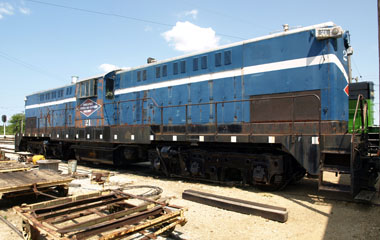
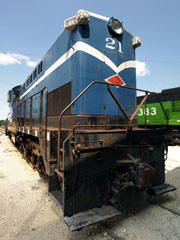
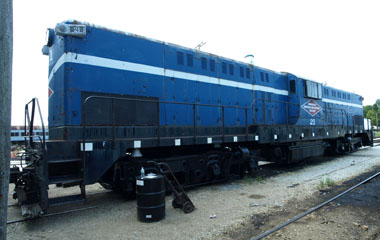
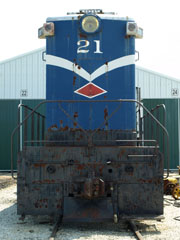

After rostering a number of second and third-hand steam engines, the C&G began dieselising in 1945, but no Alco or General Motors designs suited the railroad so it turned instead to Baldwin, purchasing five Baldwin DRS 6-4-15 switchers over the following year (#601-#605).
This was Baldwin's first domestic diesel order, and they were the first road units put into commercial service anywhere in the world.
Built by Baldwin-Lima-Hamilton in 1951 for the Columbus & Greenville Railroad, this AS-416 has a 4-cycle 608 SC prime mover powering a Westinghouse-WE471 generator driving four Westinghouse WE370 traction motors.
It weighs 245,800 lbs. Delivering starting tractive effort of 88,500 lbs at 25% and continuous tractive effort of 52,500 lbs at 9.2 mph, it had a top speed of 65 mph.
The Columbus & Greenville started as a narrow gauge operation in 1878 in Greenville, MS. Sold to Georgia Pacific interests in 1881, it came under the control of the Richmond & Danville Railroad and was rebuilt to standard gauge. It eventually became part of the Southern.
Three AS-416 units survive. You can see NS #616, on the North Carolina Transportation Museum page of this website.

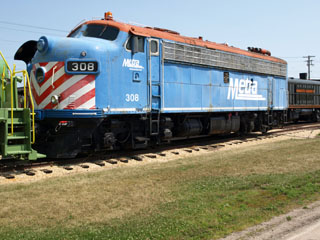
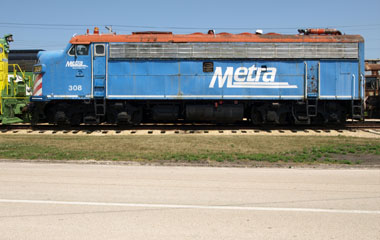
This F7 unit was built in 1949 as CNW #414, one of seventy-two A units rostered by the company, which also bought twenty-two B units. Two thousand, three hundred and sixty-six F7 A units and one thousand, four hundred and eighty-three cabless B units were built between 1949 and 1953 by EMD and its Canadian subsidiary, GMD.
The unit was sold to METRA in 1977 and leased back to the CNW. It was donated to the museum in 1999 along with METX F7 #305 (ex CNW #411).
Weighing 230,000 lbs and 50' 8" long, the F7 has a 567B 16 cylinder prime mover powering a GM D12B generator to drive four GM D27C traction motors. Delivering 40,000 lbs tractive effort at 9.3 mph, it had a top speed of 65 mph.
The fourth in EMD's line of F-unit locomotives, the F7 was the best-selling cab unit of all time. Promoted as a freight-hauler, it was also used in passenger service. You can see other F7s on the California State Railroad Museum, B&O Railroad Museum Yard & Car Shop, the Museum of the American Railroad and Cheyenne Roundhouse pages of this website.


#118-C is another EMD F7. It was built in 1951 for the Milwaukee Road, which eventually owned sixty-eight of these A units and fifty B units.
Two thousand, three hundred and sixty-six F7 A units and one thousand, four hundred and eighty-three cabless B units were built between 1949 and 1953 by EMD and GMD, its Canadian subsidiary.
Weighing 230,000 lbs and 50' 8" long, the F7 has a 567B 16 cylinder prime mover powering a GM D12B generator to drive four GM D27C traction motors. Delivering 40,000 lbs tractive effort at 9.3 mph, it had a top speed of 65 mph.

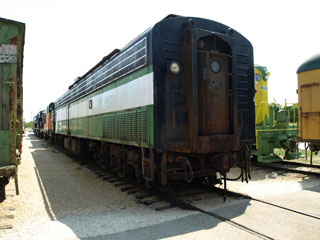
It's not clear why this EMD E9 A unit had #9961 on its left number plate on one of my visits. It was delivered to the CB&Q in 1953 as E8 #9976, one of thirty-eight rostered by that railroad. It became Burlington Northern #9976 in 1970, was sold to the West Suburban Mass Transit District in 1977 and then leased back to the BN.
Originally a 2,250 hp unit, it was upgraded to 2,400 hp by Morrison-Knudsen of Boise, ID, in 1978 by replacing its twin 12 cylinder 567B prime movers with 645CEs and its twin steam generators with Detroit Diesel powered HEP units. It was then reclassified as an E9AM unit and renumbered #9908. It later became MARC #68 then MARC #92.
#9961 is 70' 3" long, and weighs 315,000 lbs.
It delivered 31,000 lbs continuous tractive effort at 11 mph and had a top speed of 85 mph.
You can see another CBQ E8 converted to an E9, CBQ #9913, on the Gold Coast Railroad Museum page of this website. BN-3, shown earlier on this page, is also another E8 unit converted to an E9.


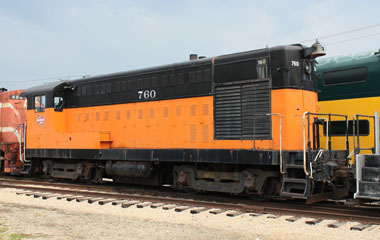
Weighing 240,000 lbs and
48' 10" long, a 2-cycle 38D8 1/8 two-stroke opposed piston prime mover powered a Westinghouse WE481B generator to drive four Westinghouse WE362B traction motors.
Designed primarily for switching, they had a starting tractive effort of 72,000 lbs and delivered 34,000 lbs tractive effort at 8.9 mph with a top speed of 60 mph.
Originally delivered as MILW #1802 in August 1944, this is the first locomotive constructed by Fairbanks–Morse in their Beloit, WI, plant.
The company had developed a diesel engine used on much of the US Navy's WWII submarine fleet. With two pistons in each cylinder, it generated nearly twice as much power from the same number of cylinders as other engines. Taking advantage of the post-war railroad push for dieselisation, Fairbanks Morse introduced the H-10-44 with what was then the most powerful engine available in a diesel.
One hundred and ninety-five
H-10-44s were built, all for US railroads, from 1944 to 1950. The Milwaukee Road bought twenty-three, but the largest purchaser was the Pennsy, which eventually rostered fifty-five. Transferred to Penn Central in 1968, none survived.
You can see MILW H-10-44 #767 on the National Railroad Museum page of this website.
Raymond Loewy designed the H-10-44's carbody with its slanted nose, sloping hood and protruding roof visor on the rear of the cab.
This styling was carried through to the H-12-44, until 1952 when the exterior design was "Spartanized" to reduce production costs.
Three hundred and thirty-eight H-12-44s were built from 1950 to 1961. You can see BMH H-12-44 #1860 with the rear roof visor on the North Carolina Transportation Museum page of this website. SWPX H-12-44 #115 without the visor is on the Museum of the American Railroad page.


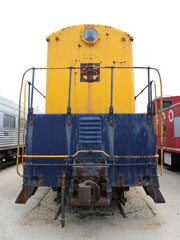
Fairbanks Morse built three of these bespoke
H-12-44 units for the AT&SF in 1956, although the design also incorporates elements from the H-16-44 (e.g. the hood recess for the cab door, the high mounted headlight and louvred box on the running boards for the main air reservoirs).
They were essentially lengthened H-12-44 switchers with a short hood housing a steam generator. This was necessary to keep the trainline from freezing as passenger consists were shuffled between the AT&SF's 21st Street Chicago Yard and Dearborn Station.


#543 is 55' 4" long and weighs 246,000 lbs. 2-cycle 38D8 1/8 prime mover powers a Westinghouse WE481G generator to drive four Westinghouse WE362B traction motors developing 34,000 lbs continuous tractive effort at 8.9 mph with a top speed of 60 mph.
BMH H-12-44 #1860 on the North Carolina Transportation Museum page of this website and SWPX H-12-44 #115 on the Museum of the American Railroad page

These road switchers were not particularly popular, and only ninety-six H-20-44 units were produced from June 1947 to March 1954, all for US railroads.
As well as problems with the relatively radical design, few railroads saw sufficient value in moving freight in greater quantities or at higher speeds than was possible with the typical 1,500 and 1,600 hp four-axle road switchers already available. Also limiting its utility as a true road unit was its lack of a short hood.
At 2,000 hp, the Fairbanks Morse H-20-44 was a heavier duty version of the 1,000 hp H-10-44 (the first production model H-10-44, MILW #760, is shown earlier on this page). It also shared the same platform and much of the carbody design as the lighter duty H-15-44, which began production three months after the H-20-44.
Like other FM switchers, the H-20-44 began with various Raymond Loewy designed features, only to have most of them later stripped as a cost cutting measure.
This unit was the second H-20-44 built by Fairbanks Morse and one of eleven sold to the Union Pacific in 1947 (#1360-#1370) where it was renumbered #1360. At some point, it was sold to Southwest Portland Cement and renumbered #409.
Weighing 240,000 lbs and 51' long, a 2-cycle 38D8 1/8 prime mover powers a Westinghouse WE474A generator to drive four Westinghouse WE37DE traction motors delivering 55,000 lbs continuous tractive effort at 12.9 mph. Top speed was 60 mph.

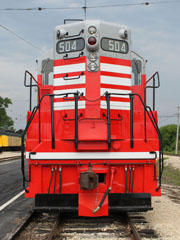

This immaculately liveried EMD SD24 was standing in the yard the last time I visited.
The unit was built as CBQ #504 in 1959. One of sixteen delivered that year to the CB&Q, it was also one of sixty-eight built for various US railroads with a high short hood.
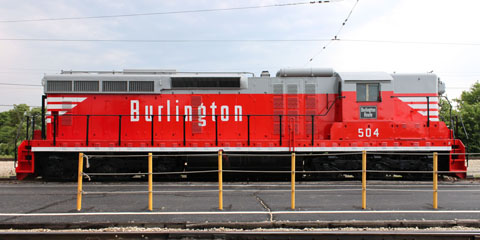

#504 was renumbered #6244 when it joined the Burlington Northern in 1970.
One hundred and seventy-nine SD24 A units and forty-five cabless B units were built by EMD between 1958 and 1963, all for US railroads. Weighing 390,000 lbs and 60' 8" long, they were equipped with a 567D3 16 cylinder prime mover powering a GM D22 generator to drive six GM D47 traction motors, one on each axle, producing 2,400 hp. The unit delivered 97,500 lbs starting tractive effort and 72,300 lbs continuous tractive effort at 9.3 mph with a top speed of 65 mph. #504 is one of only two SD24s to have survived. You can see the other survivor, WC SD24 #2402, on the National Railroad Museum page of this website.



Built as BN #6539 in 1971, this EMD SD45 was sold to Wisconsin Central in 1986 as #6539 and subsequently renumbered #6525 and then #7525. It has a 645E3 prime mover powering an AR10 generator to drive six EMD D77 traction motors delivering continuous tractive effort of 82,100 lbs at 11 mph and top speed of 65 mph.
A total of one thousand, two hundred and sixty of these 368,000 lb, 65' 9½" long units were built for US railroads from 1965 to 1971. Buyers included the Southern Pacific, AT&SF and Northern Pacific. Some are still in operation and a number have been preserved.
You can see the first production model built by EMD in 1965 on the Lake Superior Railroad Museum page of this website: #400 was delivered to Great Northern's Minneapolis Junction Roundhouse in St. Paul, MN, in May 1966 and was christened "Hustle Muscle".
WC SD45 #7495 is also on the Lake Superior Railroad Museum page, NW SD45 #1776 is on the Virginia Museum of Transportation page and SP SD45 #7475 is on the Ogden Union Station page.

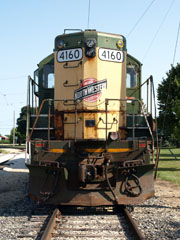
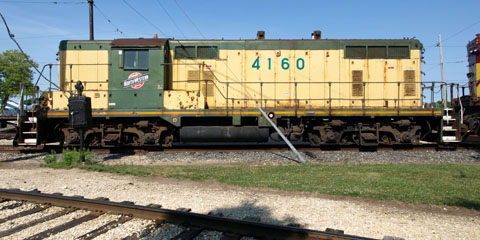
CNW #4160 was built for the Rock Island in 1952 as #1266. It was renumbered #4506 and rebuilt in 1975 or 1976 in Silvis, IL, hence the "R" in GP7R. A number of GP7 units were rebuilt by different railroads. You can see NW GP7U #2185 (formerly ATSF #2739) on the Crewe Railroad Museum page of this website.
The GP7 was astoundingly successful. Two thousand, seven hundred and twenty-nine were built from 1949 to 1954, two thousand, six hundred and fifteen for US railroads, one hundred and twelve for Canadian and two for Mexican railroads. Extremely versatile, they hauled freight and passenger services, as well as operating as switchers. It was the first EMD road unit to use a hood unit instead of a car-body design. With an EMD 567B 16 cylinder prime mover powering a GM D12 generator to drive four GM D27B traction motors, it delivered 40,000 lbs continuous tractive effort at 9.3 mph and had a top speed of 65 mph.
You can see other GP7s on the Gold Coast Railroad Museum page of this website, the B&O Railroad Museum Yard & Car Shop and Virginia Museum of Transportation pages.

EMD built three thousand, four hundred and forty-four GP9s for US railroads, six hundred and forty-six for Canadian railroads and twenty-five for other countries from 1954 to 1963. US production ended in 1959, but an additional thirteen units were built by GMD in Canada, including the last two in August 1963.
Weighing 249,000 lbs and 56’ 2” long, #902 is equipped with a 567C 16 cylinder prime mover powering a GM D12B generator to drive four GM D37 traction motors, one on each axle. Delivering starting tractive effort of 62,750 lbs at 25% and continuous tractive effort of 44,600 lbs at 9.3 mph, it has a top speed of 65 mph.

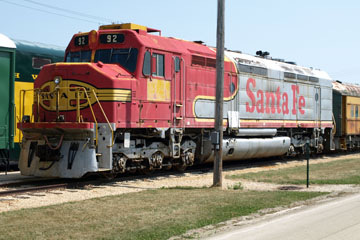
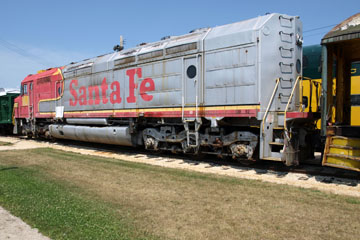
#92 is an EMD FP45 cowl unit diesel locomotive produced at the request of the Atchison, Topeka & Santa Fe Railway. The FP45 was designed by EMD specifically for the AT&SF, which did not want its prestigious Super Chief, El Capitan and other "varnish" passenger trains pulled by freight-style hood-unit locomotives with external walkways.
The unit was therefore basically just an SDP45 under a cowl. Like the SDP45, it was equipped with a V20 645E3 prime mover powering a GM AR10 generator to drive four GM D77 traction motors. Weighing 360,000 lbs and 72' 4" long, only fourteen were produced from 1967 to 1968, nine for the AT&SF (#100-#108) and five for the Milwaukee Road (#1-#5).

#92 was delivered as #102 in 1967. When Amtrak took over passenger services in 1971, the AT&SF FP45s were reassigned to fast freight service, repainted in the standard blue and yellow freight scheme and renumbered. Eventually, the units were repainted in a modified AT&SF "Warbonnet" and renumbered.
#102 was renumbered #5942 in 1970 and #5992 in 1982. It was retired in 1997 and donated to the museum. ATSF #97, which you can see on the Museum of the American Railroad page of this website, was the last FP45 in service.
The FP45 cowl unit was used on many subsequent units produced by EMD and GE. For example, you can see it on several of the modern units shown passing the New York Central Museum on the page on this website.

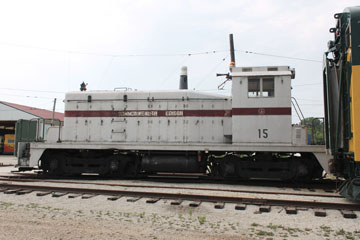

Commonwealth Edison bought six EMD SW1 switchers in 1950 (#10-#15). They worked at various plants across northern Illinois. #15 is still in operating condition and is one of the most frequently used diesels at the museum.
Six hundred and sixty-one of these 600 hp switchers were built by EMD between 1938 and 1953, all but one for US railroads. Pre-1945 units were powered by an EMD 567 prime mover.
Post-1945 models had an improved 567A prime mover. They weigh 201,500 lbs and deliver tractive effort of 34,000 lbs at 11 mph.
Eleven SW1 switchers have been preserved at various museums.
You can see CG #1 on
the Savannah Roundhouse Museum page of this website, and Pere Marquette #11 is on the B&O Museum Yard page. That unit is apparently still operational.
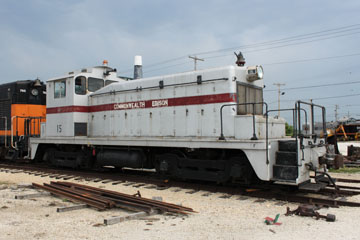
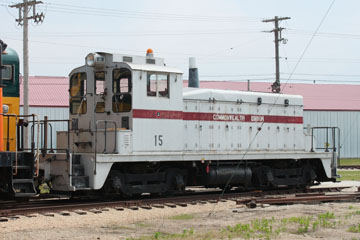

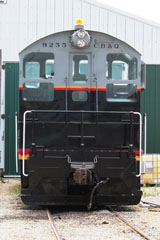
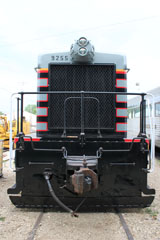
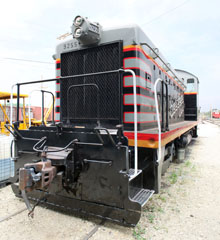
Weighing 248,000 lbs and
44' 5" long, the SW7 switcher was equipped with a V12 567A prime mover developing 1,200 hp and powering a GM D15C generator to drive four GM D37 traction motors, one on each axle.
With starting tractive effort
of 62,000 lbs at 25% and 36,000 lbs at 11 mph, it had a top speed of 65 mph.
CBQ EMD SW7 #2955 has been beautifully restored to its original livery, complete with the "Way of the Zephyr" strap line emblazoned on the hood. It was one of twelve delivered to the CB&Q in in May 1950 (another eight followed in July). Renumbered BN #121 in 1970 it was later sold to the Davenport Rock Island & North Western as #121.
EMD built four hundred and eighty-nine SW7 diesel switchers from 1949 to 1951, the majority at EMD Plant #3 in Cleveland, OH, and all for US railroads.

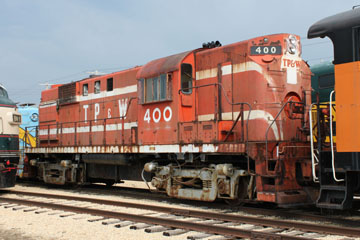
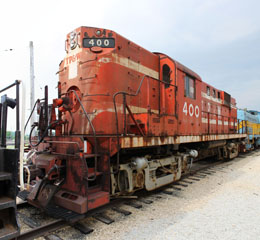
Weighing 250,000 lbs and 56' 11" long, #400 is the first of two bought by the Toledo Peoria & Western (#400 & 401) in 1958. One more was purchased in 1959 (#402).
Its 251B V12 prime mover, GE GT581 generator and four GE 752 traction motors delivered 47,000 lbs continuous tractive effort at 8 mph, with a top speed of 65 mph. DLW
RS-11 #1804 is on the Steamtown Yard page of this website.
The first RS-11s were outshopped by Alco in early 1956 to replace their very popular RS-3 road switcher and as an alternative to EMD's highly successful GP9. The turbocharged RS-11 accelerated faster, delivered higher tractive effort and used less fuel than their competition. It was also quite versatile, hauling heavy freight and passenger trains as well as switching.
Three hundred and fifty-six RS-11s were produced by Alco from 1956 to 1961. A further seventy-five were produced by the Montreal Locomotive Works in Canada from 1963 to 1964.

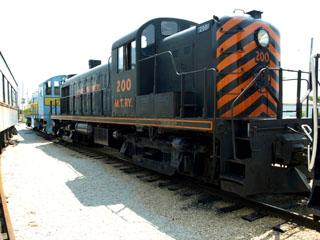

#200 is one of two
RS-3s delivered to the Minnesota Transfer Railway in 1951.
The MTFR was owned by nine major railroads serving the Twin Cities from 1883 to 1987. It provided transfer and terminal services, as well as serving local industrial customers.
One thousand, two hundred and sixty-five RS-3 units were produced for US railroads, forty-eight for Brazil, six for Cuba, ten for Mexico and five for Algeria. Ninety-eight were built for Canadian railroads by Alco subsidiary, the Montreal Locomotive Works.
Weighing 229,000 lbs and 55' 11" long, their Alco 244 12 cylinder 1,600 hp prime mover powers a GE 581 generator to drive four GE 752 traction motors, one on each axle, delivering 52,500 lbs continuous tractive effort at 10 mph with a top speed of 65 mph.
A number of RS-3s have survived.
You can see NN RS-3 #109 on the Northern Nevada Railroad Museum page of this website. You can also see NW RS-3 #300 on the Virginia Museum of Transportation page, WM RS-3 #195 on the B&O Railroad Museum Yard and Car Shop page, RDG RS-3 #467 on the Steamtown Yard page and LI RS-3 #1555 on the Gold Coast Railroad Museum page.


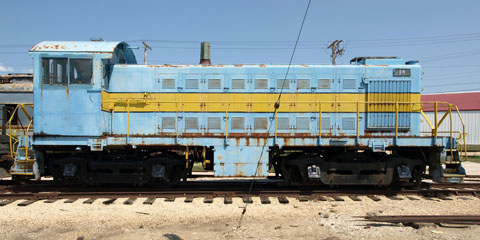
Built as South Omaha Terminal #5 in 1947, this switcher was later sold to the Nekoosa Paper Co., in Nekoosa, WI.
Weighing 210,000 lbs and 44' 5" long with a 539 6L prime mover powering a GE GT552A generator to drive six GE 731 traction motors, it delivers 46,000 lbs continuous tractive effort at 5 mph with a top speed of 60 mph. The only difference from an Alco S-1 is that the S-1 had Alco's Blunt trucks and the S-3 had standard AAR type A switcher trucks.

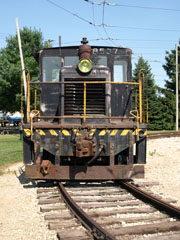
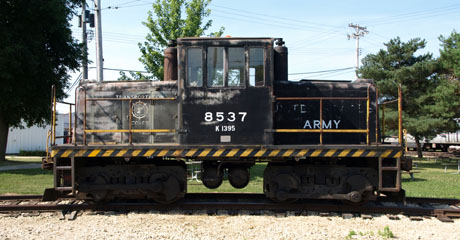
#8537 was built in 1944 by GE for the US Army. It is powered by two Cummins HB1 600 diesel engines developing 380 hp. Each engine powers a generator which, in turn, powers a motor on each truck with side rods connecting the axles.
GE's 45 ton switcher had a high weight to power ratio and excellent traction. Its short wheelbase suited industrial plants, yards and other places where clearances were tight and, although intended as switchers, they sometimes performed mainline duties.

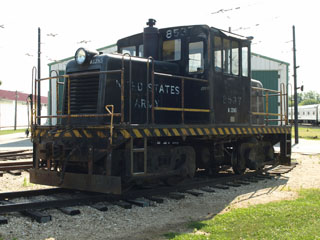
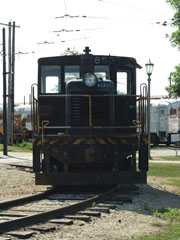
General Electric built
one thousand, two hundred and ninety-nine switchers between 1931 and 1981 ranging in size from 20 tons to 132 tons. Many of the smaller units were built with this centre cab configuration. The 45 ton model was produced from 1940 to 1956.
You can see other 44
and 45 ton GE switchers on the North Carolina Transportation Museum page of this website, the Savannah Roundhouse Railroad Museum page and the Southeastern Railway Museum, Mid-Continent Railway Museum, National Railroad Museum and Pueblo Railway Museum pages.

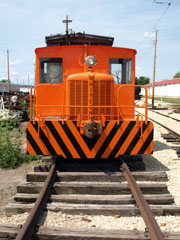
Whitcomb Locomotive Works in Rochelle, IL, built this switcher in 1951 for the Joy Manufacturing Company, a major producer of heavy underground mining equipment. Weighing 2,400 lbs and 16' 10" long, it has a Hercules DRXC diesel engine directly powering the two axles.
In 1906, Whitcomb built the first successful gasoline locomotive for
a large Central Illinois coal mine. The company was bought by Baldwin
in 1929. Production shifted briefly to Baldwin's Eddystone,
PA, site in 1952 and the last Whitcomb
locomotive was built there in 1956.

Pullman #1792 moulders behind Barn 2 on the eastern edge of the museum grounds. The
switcher was built by the Davenport Locomotive Works in Davenport, IA, in 1928. With a Buda
6-Cylinder prime mover powering two GE HM836B traction motors, it weighs 20,000 lbs and is 16' long.
Davenport Locomotive Works built locomotives in all sizes from 1902 until 1956. It acquired H. K. Porter, Inc., in 1950 and, from then on, produced Porter designs as well as its own. It ceased operations in 1955.


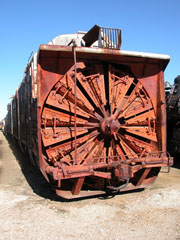
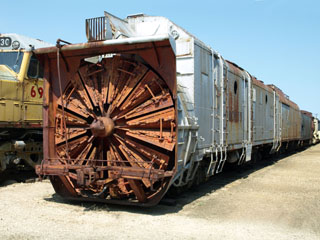

#900075 is a steam powered rotary snow plow built in 1949 by Lima-Hamilton as Union Pacific #079. The 104' 1" long plow and tender weigh 303,000 lbs.
The plow was retired in 1979. It was then donated to the Smokey Hills Chapter of the National Railroad Historical Society and displayed at a railroad museum in Kansas City. It was later acquired by the IRM.

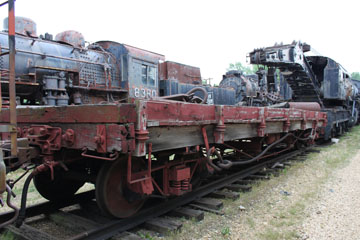

This steam powered 100 ton wrecker was also built by the Industrial Works at Bay City, MI, in 1906. It is 29' 10" long and weighs 119,000 lbs. It is coupled to CWI idler flat #1904.
You can see more Industrial Works and Industrial Brownhoist cranes on the Railroad Museum of Pennsylvania Yard page of this website, the B&O Museum Yard & Car Shop, the Virginia Museum of Transportation, Nevada Northern Railroad Museum, Ogden Union Station, Lake Superior Railroad Museum and Gold Coast Railroad Museum pages.
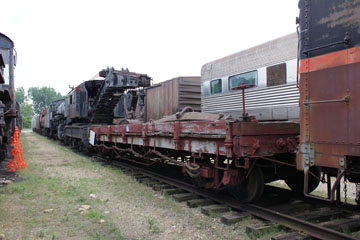
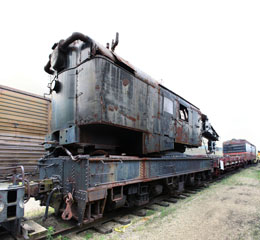

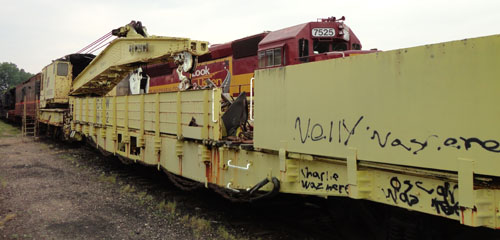
Founded in 1880, Bucyrus was an early producer of industrial steam shovels and is till in business marketing mining equipment, drag lines, trucks, shovels and excavators.
You can see other Bucyrus cranes on the Lake Superior Railroad Museum page of this website, the North Carolina Transportation Museum page and the Steamtown page.
The Bucyrus Foundry and Manufacturing Company headquartered in Bucyrus, OH, built this diesel powered 160 ton crane, although the actual build date and its total weight are not currently known.
The crane's car is 58' 7" in length and 10' 8" wide with a 15' 5" tall cab. It is on display coupled to Chicago Great Western Idler Flat Car #W5.
Related Links:
Illinois Railway Museum Website
Atchison Topeka & Santa Fe Railway Subjects
Santa Fe Railway Historical & Modeling Society
Burlington Route Historical Society
Friends of the Burlington Northern
Chesapeake & Ohio Historical Society
Chicago & North Western Historical Society
Grand Trunk Western Historical Society
Illinois Central Railroad Historical Society
Milwaukee Road Historical Association
Union Pacific Historical Society
Send a comment or query, or request permission to re-use an image.


